
![]()
Search the Journey to Forever website – click HERE
|
Journey to Forever: Make a donation |
Navigation
Contact usTo Keith Addison Handmade Projects |
Resources for city farms
See below: Resources for Community gardening
Quality check
 Extech RF15 Refractometer -- 0-32% Brix Sucrose Refractometer with Automatic Temperature Compensation. Measures the concentration of sugar from 0 to 32% Brix. Max resolution 0.2% Brix. Only requires 2 or 3 drops. Simple, repeatable measurements. See Brix levels for full details and quality chart. Buy at Amazon.com:
Extech RF15 Refractometer -- 0-32% Brix Sucrose Refractometer with Automatic Temperature Compensation. Measures the concentration of sugar from 0 to 32% Brix. Max resolution 0.2% Brix. Only requires 2 or 3 drops. Simple, repeatable measurements. See Brix levels for full details and quality chart. Buy at Amazon.com:
Extech RF15 Refractometer
City Farmer's Urban Agriculture Notes, by City Farmer, Canada's Office of Urban Agriculture -- large site, long at the centre of the burgeoning urban farming movement. Thorough coverage of all aspects of this fascinating and hopeful subject, from community gardens through school gardens, green roofs in Berlin and Chicago, organics, compost, vermiculture, composting toilets, edible parks, to the millions of destitute people fighting hunger and pollution in Third World shantytowns, and much more.
http://www.cityfarmer.org/
Site search engine:
http://www.cityfarmer.org/htdig/search.html
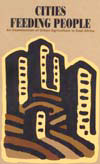 "Cities Feeding People: An Examination of Urban Agriculture in East Africa" by A. Egziabher, D. Lee-Smith, D. Maxwell, P.A. Memon, L.J.A. Mouget, C.J. Sawio, 1994, IDRC, ISBN 0-88936-706-X
"Cities Feeding People: An Examination of Urban Agriculture in East Africa" by A. Egziabher, D. Lee-Smith, D. Maxwell, P.A. Memon, L.J.A. Mouget, C.J. Sawio, 1994, IDRC, ISBN 0-88936-706-X
Food prices have soared in the South, and the urban poor can't afford it. By the late 1980s, cities of the developing world had to import half their food supply. It's argued that urban agriculture can reduce this dependency -- but most Southern governments do not support it. This book examines urban agriculture in East Africa and proves that it a safe, clean, and secure method to feed the world's struggling urban residents. It documents the extensive role urban agriculture already plays in East Africa, with detailed case studies from Tanzania, Uganda, Kenya and Ethiopia. Solid facts to convince governments that urban agriculture should play a larger role in feeding the urban population. Download free (1.2 Mb pdf):
https://idl-bnc.idrc.ca/dspace/bitstream/123456789/9824/35/98206.pdf
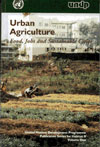 "Urban Agriculture: Food, Jobs and Sustainable Cities" by Jac Smit, Annu Ratta and Joe Nasr, UNDP, Habitat II Series, 1996, ISBN 9211260477
"Urban Agriculture: Food, Jobs and Sustainable Cities" by Jac Smit, Annu Ratta and Joe Nasr, UNDP, Habitat II Series, 1996, ISBN 9211260477
The experience of urban farming in countries across Asia, Africa and Latin America in one book, based on exploratory trips to more than 20 countries and extensive research over many years. Is urban farming a marginal activity practised for survival by the poor, just a relic of rural habits, or is it a modern economic activity with major significance for food security, stable family incomes and a livable urban environment? The book examines urban food production systems (including animals) worldwide. Well-researched, with many case studies and pictures, helpful perspectives on the current status and potential of food and income production in the city. Who the farmers are, where they farm, what the crops are, the benefits and constraints, the legislative, urban management and market environment, the history and current status of urban farming. The book fills an information gap about city farming and presents a convincing case for urban food production. Commissioned by the Urban Agriculture Initiative of the UNDP. Buy online from Chapters.ca:
http://www.chapters.ca/Affiliates/ItemPage.asp?
PRODUCTTYPE=1&AFFID=103667&ISBN=9211260477
Detailed review by City Farmer:
http://www.cityfarmer.org/smitbook90.html#smit
The Urban Agriculture Network -- The Urban Agriculture Network (TUAN) was formed in 1993, and now has 3,000 members in 40 (primarily developing) countries. Information and technical referral service, networking among groups, sponsorship for regional workshops and newsletters, advice on Urban Agriculture policy, and support for research. Contact Jac Smit (President), email UrbanAg2@cs.com
http://www.cityfarmer.org/TUAN.html
"What Would the World be Like in the 21st Century if Cities Were Nutritionally Self-Reliant? -- The prospect for Urban Agriculture" by Jac Smit, President, Urban Agriculture Network, co-author of "Urban Agriculture: Food, Jobs, and Sustainable Cities".
http://www.cityfarmer.org/21century98.html#21century
Container Farming -- Organic food production in the slums of Mexico City. Fifteen million Mexicans live in extreme poverty -- above all in marginal urban areas like the slums of Mexico City. Seven years ago a group of NGOs launched a project to help people there to grow their own food organically in small backyards or patios, balconies, rooftops -- as a way to help counteract the poverty being imposed upon them. This is the report on the project, by sociologist and community worker Rodrigo A. Medellín Erdmann.
Urban Agriculture And Livestock In The City Of Mexico: An Option For A Sustainable Future -- "Our research has reported that producers keep an average of 3 pigs and 26 birds per household, but there are some individuals who manage up to 60 pigs, all kept within the family... Their nutrition is based on the use of food wastes available from the city including kitchen wastes, stale bread and tortilla, left-over tortilla dough, chicken guts, and fruit and vegetable wastes from the markets, amounting to 4,000 tonnes per day." By City Farmer.
http://www.cityfarmer.org/mexico.html#mexico
`Resource Centre on Urban Agriculture and Forestry (RUAF), based in the Netherlands, international perspective, particularly on Third World issues. Urban Agriculture Magazine, in English, Spanish and French, published three times a year, full text at the website; good library of online documents and resources, bibliographic urban agriculture database, search online or download, news, links and more.
http://www.ruaf.org/
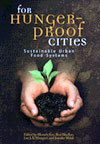 "For Hunger-proof Cities: Sustainable Urban Food Systems" edited by Mustafa Koc, Rod MacRae, Luc J.A. Mougeot, and Jennifer Welsh, 1999, IDRC, ISBN 0-88936-882-1
"For Hunger-proof Cities: Sustainable Urban Food Systems" edited by Mustafa Koc, Rod MacRae, Luc J.A. Mougeot, and Jennifer Welsh, 1999, IDRC, ISBN 0-88936-882-1
With massive growth in urban populations and hunger and malnutrition on the increase worldwide, this is the first full examination of food security from an urban perspective. It examines existing local food systems and ways to improve food access and availability for city dwellers. It looks at ways to improve community-supported agriculture and cooperation between urban and rural populations, the emerging forms of food-distribution systems and how they can contribute to alleviating hunger in the cities, and the underlying structures that create poverty and inequality. It includes contributions from farmers and professors, young activists and experienced business leaders, students and policymakers, community organizers and practitioners. Download free (13.5 Mb pdf):
https://idl-bnc.idrc.ca/dspace/bitstream/123456789/22794/32/113505.pdf
"Growing Better Cities: Urban Agriculture for Sustainable Development" by Luc J.A. Mougeot, International Development Research Centre 2006, ISBN 1-55250-226-0.
This book serves as a focal point for an IDRC thematic Web site on urban agriculture: http://www.idrc.ca/in_focus_cities. The full text is available online and leads the reader into a virtual web of resources that explores two decades of research into this important issue. Read online:
http://www.idrc.ca/en/ev-95297-201-1-DO_TOPIC.html
"Growing Food in Cities" by Tara Garnett, 1996, National Food Alliance/SAFE Alliance, ISBN 1-889779-35-3
Thorough overview of urban food growing and why it's important for sustainable development. Agenda 21, community development, health-promotion, environment, marketing, leisure services, education, and more. Download pdf, 548kb
http://peoplesgrocery.org/brahm/wp-content/uploads/2006/10/growing%20food%20in%20cities.pdf
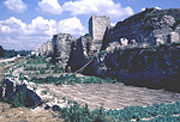 Urban farming outside the ancient walls of Istanbul (Arid Lands Newsletter No. 42) |
http://ag.arizona.edu/OALS/ALN/aln42/aln42toc.html
"Urban trees in arid landscapes: Multipurpose urban forestry for local needs in developing countries" by Guido Kuchelmeister, in Arid Lands Newsletter No. 42, Fall/Winter 1997, Urban Agriculture in Drylands -- Trees can contribute significantly to the food requirements of the urban poor, both on a daily basis and in times of crisis. Urban forests improve the quality of urban life in many ways. Tangible benefits include fuelwood, food, fodder, and building materials. Environmental and social benefits relate to public health, recreation, and well-being of the urban population, including reduction of air and noise pollution, climate improvement, and landscape enhancement. Green areas also provide habitats for wildlife, erosion control, protection of watersheds for urban water supply and productive uses or safe disposal of urban wastes.
http://ag.arizona.edu/OALS/ALN/aln42/kuchelmeister.html
"Farming in the City: The Rise of Urban Agriculture", IDRC Reports, October 1993 (Volume 21, Number 3) -- Millions of people in the growing cities of the South have become urban farmers in recent decades. They grow vegetables, raise livestock, poultry and fish, and practise many other types of agriculture. They enjoy better diets, higher income, employment or combinations of all these benefits. Urban farming also brings major benefits to the urban environment, putting marginal lands to good use, absorbing wastes in the form of compost and fertilizer, and has a positive impact in water issues and energy management. It is a new vision of the city, seen as part of the natural resource base and as a producer of agricultural goods rather than only as a consumer. Overview -- Urban Food Self-Reliance, New Challenges for China's Urban Farmers, A Plot of One's Own in West African Cities, Farming Logic in Kampala, Recognizing Ethiopia's Urban Farmers, Breaking New Ground in Dar es Salaam, The Neglected Industry of Kenyan Cities, Chasing Away Hunger in Bolivia, and more.
http://archive.idrc.ca/books/reports/V213/index.html
"Vegetable Gardens in the City, Zimbabwe" -- Adrienne Martin and Nicolienne Oudwater from the NRI have investigated how poor urban farmers -- who are mostly women -- can help to feed their families and earn cash on urban plots in three areas around Harare. They have found that in some parts of the city more than two-thirds of households carry out some farming, either around their homes or on public land such as roadside verges. Aerial surveys suggest that the area of the city under cultivation has doubled in the past decade. (From "In the Field", BBC World Service and the Natural Resources Institute of the University of Greenwich.)
http://www.nri.org/InTheField/harare_peri_urban.htm
"Above-Ground Gardens" by Dr. Martin L. Price & Laura S. Meitzner, 1996, ECHO Technical Note (from Ch 17 of ECHO's book Amaranth to Zai Holes, 1996), Educational Concerns for Hunger Organization (ECHO)
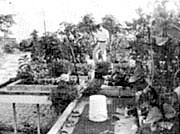 Urban food production is often overlooked by development planners. There is considerable potential to involve millions of city families in food production, who may not at first seem to have anywhere to garden -- where there is plenty of sunshine but either no soil or the soil does not lend itself to cultivation. ECHO and others have developed "above-ground" techniques suited for such sites: the countless hectares of sturdy, flat cement rooftops and many more hectares of tin roofs on insubstantial shanties, steep hillsides, extremely poor soils, yards of rock or cement, spaces around tree roots, and places where land tenure is so unstable that only portable gardens are attractive. ECHO has been working on methods for gardening in such situations since 1982. Amaranth to Zai Holes, online version, Chapter 17, Above-ground Gardens:
Urban food production is often overlooked by development planners. There is considerable potential to involve millions of city families in food production, who may not at first seem to have anywhere to garden -- where there is plenty of sunshine but either no soil or the soil does not lend itself to cultivation. ECHO and others have developed "above-ground" techniques suited for such sites: the countless hectares of sturdy, flat cement rooftops and many more hectares of tin roofs on insubstantial shanties, steep hillsides, extremely poor soils, yards of rock or cement, spaces around tree roots, and places where land tenure is so unstable that only portable gardens are attractive. ECHO has been working on methods for gardening in such situations since 1982. Amaranth to Zai Holes, online version, Chapter 17, Above-ground Gardens:http://www.echotech.org/technical/az/aztext/azch17.htm
Overview of Above-ground Gardening:
http://www.echotech.org/technical/az/aztext/azch17ov.htm
Technical Details of Above-ground Gardens:
http://www.echotech.org/technical/az/aztext/azch17ov.htm#Tech
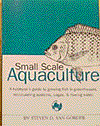 "Small Scale Aquaculture: A Guide to Backyard Fish Farming" by Steven D. Van Gorder, 1992, Rodale Institute, ISBN 0-9677732-0-2
"Small Scale Aquaculture: A Guide to Backyard Fish Farming" by Steven D. Van Gorder, 1992, Rodale Institute, ISBN 0-9677732-0-2Details and plans on how to raise, harvest, prepare, and store over 100lbs of fish in five months. This system is the result of eight years of research at the Rodale Research Center. A simple and efficient way to produce your own fish on a scale appropriate for a self-sustaining household. Makes home aquaculture as practical as gardening for providing healthy food for a family. Features an ecologically sound recirculating system designed for low energy and low water use made from readily available materials. Buy at Rodale Institute Bookstore:
http://www.rodaleinstitutestore.org/store/customer/
product.php?productid=910&cat=354&page=1
Roofwater Fish Farm Ideal For Learning -- Australian Vivienne Hallman is proving that urban fringe farmers can grow native fish successfully on natural foods. Most of the water can come from a home rooftop. Much of the fish food can be home-grown earthworms and insect larvae. Vivienne's project has shown how Australian native fish could be reared in a small area on worm-farmed kitchen scraps -- to give benefits to a vegetable or fruit tree garden. "One crop a year of silver perch is possible with unheated water," she said. Up to 50 fish a year can be raised in a 4,000-litre [900 gallons], unheated tank, to 350 to 400 gram size [about 1-lb]. "This means each of my five tanks is capable of raising 17 to 20 kg [37-44 lb] of silver perch under the non-stressful growing conditions I favour," Vivienne said.
http://www.cityfarmer.org/fishfarm.html
See Aquaculture for small farms: Aquaculture resources
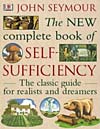 "The New Complete Book of Self-Sufficiency" by John Seymour, Foreword by E. F. Schumacher, 1976, 1997, 2003, Dorling Kindersley, ISBN 0751304263
"The New Complete Book of Self-Sufficiency" by John Seymour, Foreword by E. F. Schumacher, 1976, 1997, 2003, Dorling Kindersley, ISBN 0751304263Seymour has been described as the 'guru' of self sufficiency and says it all in this book. From planning a 1 or 5 acre plot to crop rotation, from making bread to building a furnace. Essential accessory to self-sufficiency, whether you need to remove a tree stump, butcher livestock, harness a ploughhorse, plan a dairy or dress stone. Features many forgotten crafts that have been lost in favour of convenience food and supermarkets. Comprehensive. Great drawings and all the information you need. 312 pages. Buy at Amazon.com: The New Complete Book of Self-Sufficiency
"City Harvest: The feasibility of growing more food in London" -- by Tara Garnett, 1999, Sustain, ISBN 1-9030-60-01-x
"Using a productivity level of 10.7 tonnes/ha drawn from research into allotment yields, London could produce around 232,000 tonnes of fruit and vegetables. Taking the World Health Organization's recommendation that we should eat around 0.5kg of fruit and vegetables a day (five portions), the amount potentially available would supply Londoners with 18% of their daily intake -- roughly one of the recommended five portions a day." Londoners eat 2,400,000 tonnes of food each year and produce 883,000 tonnes of organic waste. Home to only 12% of Britain's population, London nevertheless requires the equivalent of the entire productive land area of Britain to sustain itself. Order online from Sustain:
http://www.sustainweb.org/publications/order/134/
Detailed review at City Farmer:
http://www.cityfarmer.org/uk.html#uk
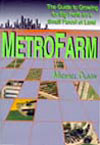 "MetroFarm: The Guide to Growing a Big Profit on a Small Parcel of Land" by Michael Olson, 1994, ISBN 0-963787-60-8
"MetroFarm: The Guide to Growing a Big Profit on a Small Parcel of Land" by Michael Olson, 1994, ISBN 0-963787-60-8According to a recent US Census of Agriculture, the most productive farmland in the United States is in the Borough of the Bronx, the second most productive farmland is in the City of San Francisco. How to earn up to eight times the average personal income on as little as one acre of land. Written for both the experienced and the novice, MetroFarm presents the modern and centuries-old technologies used by space-intensive farmers from around the world. Photos, charts and illustrations. From MetroFarm Online:
http://www.metrofarm.com/mf_Books.php
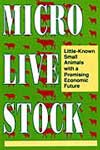 "Microlivestock: Little-Known Small Animals with a Promising Economic Future", 1991, Board on Science and Technology
"Microlivestock: Little-Known Small Animals with a Promising Economic Future", 1991, Board on Science and TechnologySmall animals require less feed and space and are easier to care for. This fascinating report makes suggestions for replacements for conventional livestock. Covers the microbreeds of cattle, goats, sheep, pigs, many breeds of poultry, rodents, deer, rabbits, lizards, and others, with appearance, distribution, habitat, biology, behavior, care, pros and cons, and research needs. Read it online (free) or print it out at the National Academy Press:
http://www.nap.edu/books/030904295X/html/
Buy the book at Amazon.com: Microlivestock
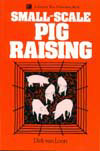 "Small-Scale Pig Raising" by Dirk van Loon, 1978, 1985, Storey, 273 pages
"Small-Scale Pig Raising" by Dirk van Loon, 1978, 1985, Storey, 273 pagesExplains exactly why raising a feeder pig is the best bet for someone with little land who wants to produce the most meat for the smallest investment of time and money. Covers everything from buying a pig to smoking your own bacon. "In writing this book I have tried to create the kind of how-to and why guide I wish I'd had when we first raised pigs." For beginners, but goes further and deeper than most introductory books. History, swine management practises through the centuries, home butchering, with step-by-step instructions and many photos covering the entire process from slaughtering to portioning meat for the freezer. Download free from the CD3WD online library (19.8Mb pdf):
http://www.fastonline.org/CD3WD_40/JF/415/05-254.pdf
Buy the book at Amazon.com: Small Scale Pig Raising
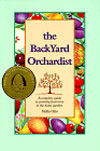 "The Backyard Orchardist: A Complete Guide to Growing Fruit Trees in the Home Garden" by Stella Otto, revised edition 1995, Otto Graphics, ISBN 0963452037
"The Backyard Orchardist: A Complete Guide to Growing Fruit Trees in the Home Garden" by Stella Otto, revised edition 1995, Otto Graphics, ISBN 0963452037Step-by-step guidance from a true expert on how to start your orchard -- planning, soil, tree selection for your climate, planting, pruning, pest management, harvesting and storing, everything you need to know. Buy at Amazon.com: The Backyard Orchardist
"Fruits of Warm Climates" by Julia F. Morton, ISBN: 0-9610184-1-0
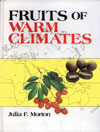 Julia F. Morton is Research Professor of Biology and Director of the Morton Collectanea, University of Miami, a research and information center devoted to economic botany. Covers 124 species, with an extensive bibliography; the entry for each species is a minor essay, with detailed treatment under Description, Origin and Distribution, Varieties, Climate, Soil, Propagation, Culture, Keeping Quality, Pests and Diseases, Food Uses, Other Uses. The approach is global -- Uses, for instance, covers the practices of traditional peoples throughout the world, including medical uses. Ms Morton provides a real wealth of information from her long experience of the subject. With photographs. Full text online:
Julia F. Morton is Research Professor of Biology and Director of the Morton Collectanea, University of Miami, a research and information center devoted to economic botany. Covers 124 species, with an extensive bibliography; the entry for each species is a minor essay, with detailed treatment under Description, Origin and Distribution, Varieties, Climate, Soil, Propagation, Culture, Keeping Quality, Pests and Diseases, Food Uses, Other Uses. The approach is global -- Uses, for instance, covers the practices of traditional peoples throughout the world, including medical uses. Ms Morton provides a real wealth of information from her long experience of the subject. With photographs. Full text online:http://www.hort.purdue.edu/newcrop/morton/index.html
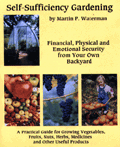 "Self-Sufficiency Gardening: Financial, Physical and Emotional Security from Your Own Backyard" by Martin P. Waterman, 1995, ISBN 1-55950-135-9
"Self-Sufficiency Gardening: Financial, Physical and Emotional Security from Your Own Backyard" by Martin P. Waterman, 1995, ISBN 1-55950-135-9Widely respected horticulturist and journalist Martin P. Waterman has prepared this practical guide for the novice and experienced gardeners. Covers the basics, organic growing, edible landscaping, greenhouses, preserving and storing, non-food and other valuable crops, earning income with your crops, and more. Traditional, time-honoured gardening techniques along with computer-gardening technology. Martin Waterman writes gardening articles for Backwoods Home Magazine, among others. This is what the magazine's publisher Dave Duffy said about this book: "If you're going to read just one gardening book in the 90s, this is the book Backwoods Home Magazine will stand behind." Buy at Amazon.com: Self-Sufficiency Gardening
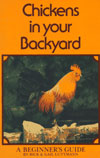 "Chickens in Your Backyard: A Beginner's Guide" by Rick and Gail Luttmann, 1976, Rodale, ISBN 0878571256
"Chickens in Your Backyard: A Beginner's Guide" by Rick and Gail Luttmann, 1976, Rodale, ISBN 0878571256Perfect for beginners, steers you round all the traps. Presupposes no prior knowledge, step-by-step style, and it's written with some wit. This was our first chicken book and we found we could rely on it -- though it's not quite as effective as one reviewer claimed: "It will have you laying eggs in days!" The chickens did, but not us! Buy at Amazon.com: Chickens in Your Backyard
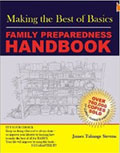 "Making the Best of Basics -- Family Preparedness Handbook" by James Talmage Stevens, 12th edition, 2010, Fulfillment Central Publishing, ISBN-10: 1934275182, ISBN-13: 978-1934275184
"Making the Best of Basics -- Family Preparedness Handbook" by James Talmage Stevens, 12th edition, 2010, Fulfillment Central Publishing, ISBN-10: 1934275182, ISBN-13: 978-1934275184The preparedness bible -- how to live on your own resources for up to a year, regardless. First published in 1974, this is still the most comprehensive book on the subject. 760,000 copies sold. This new edition has been updated with 250 new pages of charts, tables and information. The focus is on food: "Store what you eat, eat what you store, use it or lose it." Thorough. Available in both a printed version and as a digital download e-book. Comes with a free 90-minute online video. Anybody who's interested in food will benefit from this book. Buy the book: Making the Best of Basics
Resources for Community gardening
American Community Gardening Association (ACGA) -- Information centre, programs, publications, links, newsletter, Locate A Garden, Greening Events, and more.
http://www.communitygarden.org/
"Cultivating Community: Principles and Practices for Community Gardening as a Community-Building Tool" by Karen Payne and Deborah Fryman, American Community Gardening Association (ACGA) -- Explores basic principles and values of successful community empowerment programs of any kind, and illustrates how these principles have been applied to community gardens across the US. Useful tips on how to approach community gardening as an organizing tool, highlights specific practices and activities that have been proven to work. Stories and case studies from community gardens around the US. Order online:
http://www.communitygarden.org/acga-store.php
"Growing Communities: How to Build Community Through Community Gardening" by Jeanette Abi-Nader, David Buckley, Kendall Dunnigan and Kristen Markley, American Community Gardening Association (ACGA) -- An in depth exploration of the practices and strategies community organizers can use to develop dynamic leaders and create strong programs using a participatory approach to community building. 300+ page curriculum builds on the work of Cultivating Community and years of ACGA experiences, especially those of the From the Roots Up mentorship and training program. Includes a set of workshop curricula for training on each topic, based on actual FTRU workshops. Appendix with resources lists, handouts and other useful information. Order online:
http://www.communitygarden.org/acga-store.php
"What Good Is Community Greening?" by David Malakoff: "Research supports all those common sense answers you've been using for years -- but there is still more to learn." 3,500-word online article covers People-Plant Interactions, Background Theories, How Individuals Respond, Plants and Communities, Building Communities, "Greenlining", and more. From the American Community Gardening Association (ACGA) (pdf, 1.1Mb):
http://7d8ca58ce9d1641c9251f63b606b91782998fa39.
gripelements.com/docs/WhatGoodisCommunityGreening.pdf
"How Does Our garden Grow: A Guide to Community Garden Success" by Laura Berman, FoodShare Community Gardening Co-ordinator, FoodShare, Toronto -- An extensive manual on community gardening and community organizing. The manual addresses various aspects of community organizing including fundraising, organizational structure, leadership, suggested rules and regulations for peaceful co-existence among gardeners, site acquisition and site selection, as well as site design, maintenance guidelines, tools and equipment, gardening with children and for people with disabilities. Appendices provide horticultural information, composting and soil testing fact sheets and reference and resource lists. Detailed "month by month" sections provide succinct startup information for any community garden, regardless of location. For more information, contact laura@foodshare.net.To order, contact zola@foodshare.net.
FoodShare Toronto -- Working with communities to improve access to affordable, nutritious food. Non-profit food security organization based in Toronto, Canada: "Growing food in our cities, right where we live, is something that we need to do. Not sometime in the future but right now, before we forget how or the land is put to 'better' use by being paved over or built upon." Community Gardening Program: Since 1986 FoodShare has been helping community groups and individuals to start and sustain community gardens. FoodShare's expert program staff can help with all aspects of community garden development. FoodShare sponsors the Toronto Community Garden Network and publishes the Toronto Community Garden Network E-News weekly email newsletter (online archives); the Field to Table Urban Agriculture Project demonstrates new and innovative ways to grow food in cities; the Good Food Box non-profit fresh fruit and vegetable distribution system, distributes 4,000 boxes per month through 200 neighborhood-based drop-offs. Fact-sheets, resources, publications, information and more.
http://www.foodshare.net/
Community Gardening Listserve -- Mailing list operated by the American Community Gardening Association (ACGA), for Community Gardeners, Community Organizers, Master Gardeners and others interested in developing or enhancing community gardening programs to communicate via email. Discussion topics range from fund raising to soil improvement to keeping gardeners motivated. Subscribe online:
http://list.communitygarden.org/mailman/listinfo/
community_garden_list.communitygarden.org
Community Gardening Mailing list Archives:
http://list.communitygarden.org/pipermail/
community_garden_list.communitygarden.org
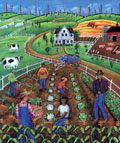 The US non-profit Community Food Security Coalition (CFSC) is dedicated to building strong, sustainable, local and regional food systems that ensure access to affordable, nutritious, and culturally appropriate food for all people at all times. Seeks to develop self-reliance among all communities in obtaining their food and to create a system of growing, manufacturing, processing, making available, and selling food that is regionally based and grounded in the principles of justice, democracy, and sustainability. CFSC has over 250 member organizations, and has awarded $13 million in grants to 102 projects.
The US non-profit Community Food Security Coalition (CFSC) is dedicated to building strong, sustainable, local and regional food systems that ensure access to affordable, nutritious, and culturally appropriate food for all people at all times. Seeks to develop self-reliance among all communities in obtaining their food and to create a system of growing, manufacturing, processing, making available, and selling food that is regionally based and grounded in the principles of justice, democracy, and sustainability. CFSC has over 250 member organizations, and has awarded $13 million in grants to 102 projects.
http://www.foodsecurity.org/
Seeds of Change: Strategies for Food Security for the Inner City, Linda Ashman, et. al., UCLA Urban Planning Dept., 1993 -- This landmark report documented the extent of inner-city hunger in Los Angeles. The product of a year's work for six researchers, it is perhaps the most thorough documentation of an urban community's food system. Sections on hunger, nutrition, food industry, supermarket industry, communmity case study, farmers' markets, urban agriculture, joint ventures, and food policy councils. Order online:
http://www.foodsecurity.org/pubs.html
A Guide to Community Food Projects, Maya Tauber and Andy Fisher, 2002 -- This 20-page guide features case studies of seven diverse and innovative projects funded by USDA's Community Food Projects grant program. It also includes basic information about the CFP program and sources for more information. The CFP program goals are to meet the needs of low-income people by increasing their access to fresher, more nutritious food supplies; increase the self-reliance of communities in providing for their own food needs; and promote comprehensive responses to local food, farm, and nutrition issues. Acrobat file, 494Kb.
http://www.foodsecurity.org/cfsc_case_studies.pdf
Urban Agriculture and Community Food Security in the United States: Farming from the City Center to the Urban Fringe, prepared by the Urban Agriculture Committee of the Community Food Security Coalition (CFSC), February, 2002, Katherine H. Brown, contributors: Martin Bailkey, Alison Meares-Cohen, Joe Nasr, Jac Smit, Terri Buchanan, editor: Peter Mann -- 11,000-word report, online or Acrobat file: The Quiet Revolution of Urban Agriculture in the United States, Food Insecurity in U.S. Cities, Urban Agriculture Builds on the Resources of Cities, The Potential for Growing Food in Cities, Who Is Raising Food in Cities?, Challenges Facing Urban Agriculture and Responses to these Challenges, Policy Changes to Promote Urban Agriculture, Resources, Publications, Websites
http://www.foodsecurity.org/urbanag.html
"Starting a Community Garden" -- this fact sheet is designed to give many different groups the basic information they need to get their gardening project off the ground.
http://www.communitygarden.org/learn/starting-a-community-garden.php
The British Foundation for Local Food Initiatives promotes the growth of healthy local food economies, as a key contribution to sustainable development. Home of FLAIR -- the Food and Local Agriculture Information Resource, a partnership project led by the Foundation to analyse the scale, scope and benefits of the local food sector in the UK, to help create a national database, and to enable the development of a national food links network. Local Food News monthy email newsletter, online and archives, directories, reports, case studies, contacts and links.
http://www.localfood.org.uk/
The Federation of City Farms and Community Gardens is a UK organisation representing groups involved in community-led development of open space through locally managed farming and gardening. News and events, city farm and community garden directories, resources and publications, how to start a city farm, kids' corner, links and contacts, special resources for members.
http://www.farmgarden.org.uk
City farms
Resources for city farms
Organic gardening
Building a square foot garden
Plant spacing guides
No ground? Use containers
When to sow what
Seeds
Garden pond
Gardening resources
Composting
Making compost
Composting resources
Composting indoors
Vermicomposting
Humanure
Composting for small farms
Small farms
Small farm resources
Community-supported farms
Farming with trees
Farming with animals
Pasture
Pigs for small farms
Poultry for small farms
Aquaculture for small farms
Composting for small farms
Controlling weeds and pests
Small farms library